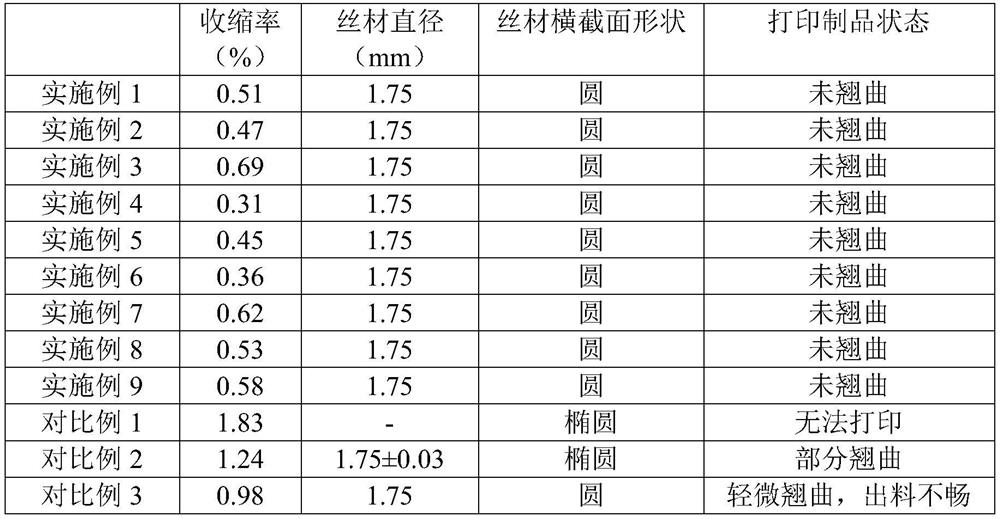A kind of low shrinkage polypropylene material suitable for 3D printing and preparation method
A low-shrinkage polypropylene and 3D printing technology, applied in the field of 3D printing materials, can solve the problems of low dimensional accuracy of printed products, low dimensional accuracy of consumables, and large shrinkage of consumables, etc., to achieve the goal of expanding the scope of use, stable application, and low cost Effect
- Summary
- Abstract
- Description
- Claims
- Application Information
AI Technical Summary
Problems solved by technology
Method used
Image
Examples
Embodiment 1
[0044] 100 parts of homopolypropylene (brand: T30H, Donghua Energy (Zhangjiagang) New Materials Co., Ltd.), 0.1 part of catalyst dibutyltin dilaurate, 0.2 part of initiator dicumyl peroxide, 2.5 parts of vinyl triethyl Oxysilane, 0.06 part of beta nucleating agent, 10 parts of talc, and 0 part of calcium carbonate were mixed uniformly in a high mixer.
[0045] The mixture is fed through the main feeding port of the twin-screw extruder, and 0.2 parts of stabilizer and 3 parts of glass fiber are added from the side feeding port. After cooling in a water tank and pelletizing by a pelletizer, granular modified Polypropylene material.
[0046] The granular modified polypropylene material is extruded through a single-screw extruder to obtain a filamentous 3D printing polypropylene consumable.
Embodiment 2
[0048] 100 parts of homopolypropylene (brand: S1003, Donghua Energy (Ningbo) New Materials Co., Ltd.), 0.2 parts of catalyst dibutyltin dilaurate, 0.1 part of initiator dicumyl peroxide, 2 parts of vinyl triethyl Oxysilane, 0.06 part of beta nucleating agent, 10 parts of talc, and 5 parts of calcium carbonate are mixed uniformly in a high mixer.
[0049] The mixture is fed through the main feeding port of the twin-screw extruder, and 0.2 parts of stabilizer and 5 parts of glass fiber are added from the side feeding port. After cooling in a water tank and pelletizing by a pelletizer, granular modified Polypropylene material.
[0050] The granular modified polypropylene material is extruded through a single-screw extruder to obtain a filamentous 3D printing polypropylene consumable.
Embodiment 3
[0052] 100 parts of homopolypropylene (brand name: M151H, Donghua Energy (Zhangjiagang) New Materials Co., Ltd.), 0.2 parts of catalyst dibutyltin dilaurate, 0.2 parts of initiator dicumyl peroxide, 2 parts of vinyl triethyl Oxysilane, 0 parts of beta nucleating agent, 5 parts of talc, and 5 parts of calcium carbonate were mixed uniformly in a high mixer.
[0053]The mixture is fed through the main feeding port of the twin-screw extruder, and 0.2 parts of stabilizer and 7 parts of glass fiber are added from the side feeding port. After cooling in a water tank and pelletizing by a pelletizer, granular modified Polypropylene material.
[0054] The granular modified polypropylene material is extruded through a single-screw extruder to obtain a filamentous 3D printing polypropylene consumable.
PUM
| Property | Measurement | Unit |
|---|---|---|
| melt flow index | aaaaa | aaaaa |
| length | aaaaa | aaaaa |
Abstract
Description
Claims
Application Information
 Login to View More
Login to View More - R&D
- Intellectual Property
- Life Sciences
- Materials
- Tech Scout
- Unparalleled Data Quality
- Higher Quality Content
- 60% Fewer Hallucinations
Browse by: Latest US Patents, China's latest patents, Technical Efficacy Thesaurus, Application Domain, Technology Topic, Popular Technical Reports.
© 2025 PatSnap. All rights reserved.Legal|Privacy policy|Modern Slavery Act Transparency Statement|Sitemap|About US| Contact US: help@patsnap.com

